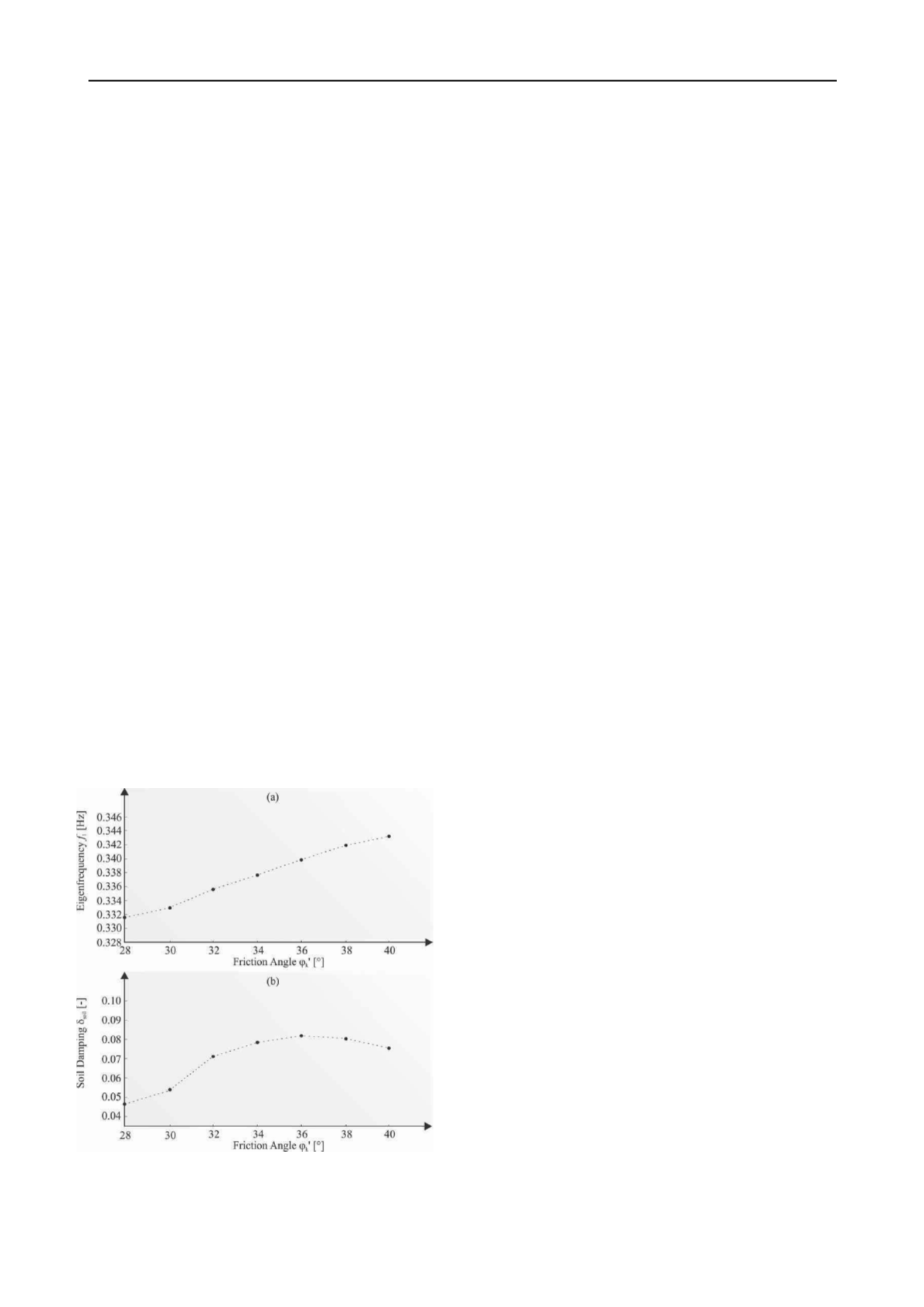
2346
Proceedings of the 18
th
International Conference on Soil Mechanics and Geotechnical Engineering, Paris 2013
the eigenfrequency
f
1
tends to increase for increasing backfill
height. The material soil damping
δ
soil
highly depends on the
pile deflection and the initial stiffness E
*
py
for each soil layer,
see Figure 3. However, the pile deflection at the base of the
scour hole only increases to a certain scour depth, and the initial
stiffness E
*
py
depends on the strength of each soil layer and the
scour depth. Hence, for increasing scour depth the pile
deflection and initial soil stiffness might increase or decrease
relative to each other. This may in turn explain the observed
behaviour of the soil damping
δ
soil
in Figure 6b.
Over a period of time the relative density
I
d
of the backfill
material might be increased due to the presence of waves
inducing depth compaction (Sørensen
et al.
2010). Hansson
et
al.
2005 have reported friction angles above 40° for
Frederikshavn sand. Figure 7 shows the eigenfrequency
f
1
and
soil damping
δ
soil
as a function of the strength of the backfill
material after the scour hole is replaced by the backfill material.
In conclusion, the Winkler approach shows a variation of
the eigenfrequency
f
1
caused by sediment transportation at the
seabed level of 8%. The model indicates a soil damping
δ
soil
in
the range of 0.05-0.08 logarithmic decrement. Hence,
comparing these results with the experimental findings in Figure
5, the time-varying modal parameters of the investigated
offshore wind turbines might be caused by sediment
transportation at seabed.
2 CONCLUSION
Wind energy is a rapidly growing interdisciplinary field that
involves many different disciplines within civil engineering.
The dynamic behaviour of the wind turbine structure is
determined by a complex interaction of components and sub-
systems. A full understanding of the structural modal
parameters is crucial in order to assess the fatigue damage
accumulation during the lifetime of the wind turbine structure.
Experimental and numerical investigations of the dynamic
properties of offshore wind turbine structures installed on a
monopile foundation have been presented in this paper. Based
on a total of 665 free vibration tests, time-varying modal
parameters are observed, which is supported by a Winkler
approach. Several interesting observations can be made:
Figure 7. Strength of backfilled material based on a Beam on Nonlinear
Winkler Foundation model: (a) Eigenfrequency
f
1
as a function of the
friction angle
φ
k
’
of the backfill material, (b) Soil damping δ
soil
as a
function of the friction angle
φ
k
’
of the backfill material.
Experimental testing indicates a high variation in the
eigenfrequency
f
1
and
the modal damping δ
1
. A 5% quantile
of 0.11 logarithmic decrement is observed, which corresponds
very well with the findings for each considered turbine.
Eliminating the tower damper performance tends to reduce
the large variation of the modal parameters. However,
distinctly time-varying eigenfrequencies
f
1
and modal
damping values
δ
1
are still obtained.
A Beam on a Winkler foundation model indicates that the
observed time-dependencies might be caused by sediment
transportation at seabed. Scour development and backfilling
change the eigenfrequency
f
1
with 8%, and the soil damping
δ
soil
varies in the range 0.05-0.08.
3 ACKNOWLEDGEMENTS
The authors are grateful for the financial support from the
research project Cost Effective Monopile Design.
4 REFERENCES
Andersen L.V. 2008. Assessment of Lumped-Parameter Models for Rigid
Footings.
Computers and Structures
. 88, 1333-1347.
Damgaard M, Ibsen L.B, Andersen L.V. and Andersen J.K.F
.
2012.
Natural Frequency and Damping Estimation of an Offshore Wind
Turbine Structure.
Proc. of the 20th Int. Offshore and Polar
Engineering Conf.
, Rhodos, Greece. 300-307.
Damgaard M, Ibsen L.B, Andersen L.V., Andersen J.K.F. and Andersen
P. 2012. Damping Estimation of Prototype Bucket Foundation for
Offshore Wind Turbines Identified by Full Scale Testing.
Proc. of
the 5th Int. Operational Modal Analysis Conf. (IOMAC),
Guimarães,
Portugal, 300-307.
Devriendt C., Jordaens P.J., De Sitter G. and Guillaume P. 2012.
Damping Estimation of an Offshore Wind Turbine on a Monopile
Foundation.
Proc. of the EWEA
2012 Conf., Copenhagen.
DNV 2011.
Design of Offshore Wind Turbine Structures
. Det Norske
Veritas AS.
Hansen M.H., Thomsen K., Fuglsang P., and Knudsen T. 2006. Two
Methods for Estimating Aeroelastic Damping of Operational Wind
Turbine Modes from Experiments.
Wind Energy.
9, 179
–
191.
Hansson M., Hjort T.H. and Thaarup M. 2005. Data Report 0408
Fredrikshavn Sand. Technical Report, Aalborg University.
Høgedal M. and Hald T. 2005. Scour Assessment and Design for Scour
for Monopile Foundations for Offshore Wind Turbines.
Copenhagen
Offshore Wind
, Copenhagen.
IEC 2005.
International Standard. Wind Turbines
–
Part 1: Design
Requirements
. European Committee for Electrotechnical Standardi-
zation, Brussels.
Nielsen S.R.K. 2004.
Linear Vibration Theory
. Aalborg Tekniske
Universitetsforlag, Denmark.
Ovesen N.K., Fuglsang L. and Bagge G. 2006.
Lærebog i Geoteknik
.
Polyteknisk Forlag, Denmark.
Sumer B.M., Fredsøe J., and Christiansen N. 1992. Scour Around a
Vertical Pile in Waves.
Journal of Waterway
,
Port, Coastal and
Ocean Engineering
, ASCE. 117, 15-31.
Sørensen S.P.H., Ibsen, L.B. and Frigaard P. 2010. Experimental
Evaluation of Backfill in Scour Holes around Offshore Monopiles.
Proc. of the 2nd Int. Symposium on Frontiers in Offshore
Geotechnics,
Perth, Australia.
Tarp-Johansen N.J., Andersen L., Christensen E.D., Mørch C., Kallesøe
B. and Frandsen S. 2009. Comparing Sources of Damping of Cross-
Wind Motion.
The European Offshore Wind Conference &
Exhibition
, Stockholm.
Tcherniak D., Chauhan S., Rosseth M., Font I., Basurko J. and Salgado
O. 2010. Output-Only Modal Analysis on Operating Wind
Turbines: Application to Simulated Data.
European Wind Energy
Conf.
, Warsaw, Poland.
Versteijlen W.G., Metrikine A.V., Hoving J.S., Smid E. and De Vries
W.E. 2011. Estimation of the Vibration Decrement of an Offshore
Wind Turbine Support Structure Caused by its Interaction with Soil.
Proc. of the EWEA Offshore
2011 Conf., Amsterdam.
Øye S. 1996.
FLEX 5 User Manual
. Lyngby.


